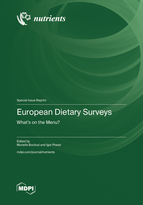European Dietary Surveys: What's on the Menu?
A special issue of Nutrients (ISSN 2072-6643). This special issue belongs to the section "Nutrition Methodology & Assessment".
Deadline for manuscript submissions: closed (31 December 2021) | Viewed by 44369
Special Issue Editors
Interests: nutrition and public health; dietary intake; salt intake; blood pressure; kidney function; micronutrients
Interests: nutrition and public health; dietary intake; macronutrients; vitamin D; free sugar; trans fatty acids
Special Issues, Collections and Topics in MDPI journals
Special Issue Information
Dear Colleagues,
This Special Issue focuses on dietary and nutrition surveys in Europe. Considerable progress has been made in harmonising the collection of food consumption data in Europe over the last decade. The European commission and the national governments have supported the use of dietary surveys as part of regular monitoring and research projects. A guidance on the dietary survey methodology was developed, enabling the realisation of comparable and harmonised studies across the continent, and generating a common European food consumption database. While this is a basis for improving exposure assessments and ensuring more targeted risk management, food consumption data are also important for assessing nutrient intakes and other studies focusing on the relationship between diet and health.
The aim of this Special Issue is to provide a space for high-quality research studies based on nationally representative dietary and nutrition surveys across Europe. We are interested in intakes of foods, nutrients and other bioactive food constituents, as well as in understanding the parameters affecting those intakes. We are also interested in extended studies which include biological biomarkers. We also encourage the submission of validation studies, country-to-country comparisons, challenges faced by the researchers and how they dealt with them, as well as methodological improvements related with nutritional epidemiology.
Prof. Dr. Murielle Bochud
Prof. Dr. Igor Pravst
Guest Editors
Manuscript Submission Information
Manuscripts should be submitted online at www.mdpi.com by registering and logging in to this website. Once you are registered, click here to go to the submission form. Manuscripts can be submitted until the deadline. All submissions that pass pre-check are peer-reviewed. Accepted papers will be published continuously in the journal (as soon as accepted) and will be listed together on the special issue website. Research articles, review articles as well as short communications are invited. For planned papers, a title and short abstract (about 100 words) can be sent to the Editorial Office for announcement on this website.
Submitted manuscripts should not have been published previously, nor be under consideration for publication elsewhere (except conference proceedings papers). All manuscripts are thoroughly refereed through a single-blind peer-review process. A guide for authors and other relevant information for submission of manuscripts is available on the Instructions for Authors page. Nutrients is an international peer-reviewed open access semimonthly journal published by MDPI.
Please visit the Instructions for Authors page before submitting a manuscript. The Article Processing Charge (APC) for publication in this open access journal is 2900 CHF (Swiss Francs). Submitted papers should be well formatted and use good English. Authors may use MDPI's English editing service prior to publication or during author revisions.
Keywords
- food consumption
- dietary intake
- dietary behaviour
- epidemiological studies
- population-based surveys
- health outcomes
- biomarkers of nutritional status
- lifestyle and other parameters affecting nutritional status
- dietary assessment methods: 24 h dietary recall
- macronutrients
- total and free sugar
- fats
- micronutrients
- vitamins
- minerals
- contaminants, trans fatty acids, acrylamide








